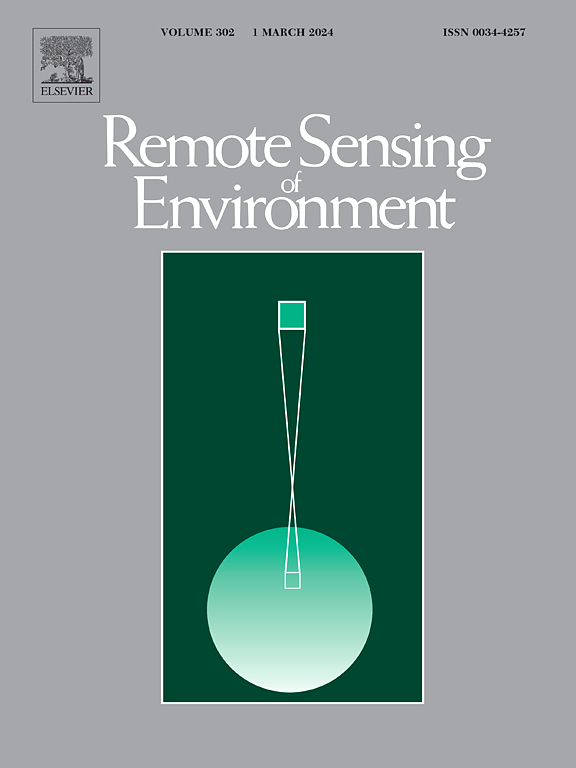基于多源数据融合的全球地表土壤和植被温度检索
IF 11.1
1区 地球科学
Q1 ENVIRONMENTAL SCIENCES
引用次数: 0
摘要
土壤和植被温度对包括生态、农业和气候变化在内的各个领域都至关重要。然而,对于这两个分量的温度,仍然缺乏完全基于观测的全球数据集。为了填补这一空白,本研究开发了一种基于多源数据融合的全球地表土壤和植被温度检索方法(FuSVeT)。该方法不仅利用MODIS数据的时空信息,采用温度循环模型捕捉时间变化,利用相邻像元考虑空间差异,增加方程求解数量,而且利用ERA5-Land数据减少未知参数,有效补偿了卫星观测的局限性。通过模拟数据、高分辨率卫星产品和现场测量对其性能进行了全面评估,在大多数情况下,其均方根误差低于2 K,偏差低于1 K,具有竞争力的精度。与以往单纯依赖卫星时空信息的检索方法相比,FuSVeT精度提高,空间覆盖更全面,计算效率提高,更适用于全球土壤和植被温度制图。利用该方法,我们生成了2020年1月和7月全球0.05°的月平均土壤和植被温度。这些数据可以捕获比现有土壤温度产品更明显的生物群系温度异质性,表明其在全球分析中的优越性。重要的是,FuSVeT还可以应用于具有更高时空分辨率的卫星观测,具有提供准确、长期、全球地表土壤和植被温度地图的巨大潜力。本文章由计算机程序翻译,如有差异,请以英文原文为准。
Retrieval of global surface soil and vegetation temperatures based on multisource data fusion
Soil and vegetation temperatures are crucial for various fields, including ecology, agriculture, and climate change. However, there remains a lack of entirely observation-based global datasets for these two component temperatures. To fill this gap, this study developed a multisource data Fusion-based global surface Soil and Vegetation Temperature retrieval method (FuSVeT). This novel method not only utilizes temporal and spatial information from MODIS data by adopting a temperature cycle model to capture temporal variation and using adjacent pixels to consider spatial differences and increase the number of equations solved, but also leverages ERA5-Land data to reduce unknown parameters, effectively compensating for the limitations of satellite observations. Its performances were comprehensively evaluated with simulated data, high-resolution satellite products, and in situ measurements, demonstrating competitive accuracy with root mean square errors below 2 K and Biases of under 1 K in most cases. Compared to previous retrieval method that relies solely on satellite-based temporal and spatial information, FuSVeT present enhanced accuracy, more complete spatial coverage, and improved computational efficiency, making it more applicable for global soil and vegetation temperature mapping. Using this method, we generated global 0.05° monthly mean soil and vegetation temperatures for January and July 2020. These data can capture more pronounced temperature heterogeneities within biomes than existing soil temperature products, indicating its superiority for global analyses. Importantly, FuSVeT can also be applied to satellite observations with higher spatiotemporal resolution, holding significant potential for providing accurate, long-term, global maps of surface soil and vegetation temperatures.
求助全文
通过发布文献求助,成功后即可免费获取论文全文。
去求助
来源期刊

Remote Sensing of Environment
环境科学-成像科学与照相技术
CiteScore
25.10
自引率
8.90%
发文量
455
审稿时长
53 days
期刊介绍:
Remote Sensing of Environment (RSE) serves the Earth observation community by disseminating results on the theory, science, applications, and technology that contribute to advancing the field of remote sensing. With a thoroughly interdisciplinary approach, RSE encompasses terrestrial, oceanic, and atmospheric sensing.
The journal emphasizes biophysical and quantitative approaches to remote sensing at local to global scales, covering a diverse range of applications and techniques.
RSE serves as a vital platform for the exchange of knowledge and advancements in the dynamic field of remote sensing.
 求助内容:
求助内容: 应助结果提醒方式:
应助结果提醒方式:


